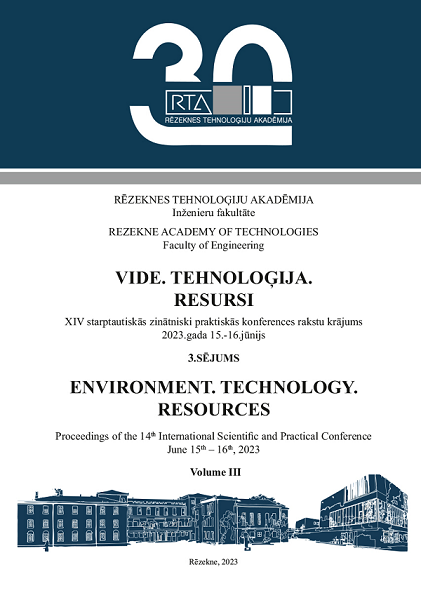EXPERIMENTAL STUDIES OF AN ALGORITHM FOR MINIMIZING THE IDLE TOOL MOVES WHEN MILLING COMPLEX SURFACES ON TRIAXIAL CNC MACHINE TOOLS
DOI:
https://doi.org/10.17770/etr2023vol3.7195Keywords:
pure/actual/finish milling, complex surfaces, CNC machine tool, optimizationAbstract
The idle running times of the working units of a machine tool are the sum of the idle running times for the tool change and for changing the section uder treatment. The time, spent on idle running is the extra machining time. A large number of milling cutters are used for purely mechanical machining of details with complex surfaces and for a significant number of machined sections, where the complex surface is broken as a rule. This leads to an increase in the extra time for treatment. Reducing the auxiliary time in machining the parts will significantly increase the productivity of the actual milling process. When modeling the process of machining details with complex surfaces on triaxial milling machines, the optimization of the sequence of moves will allow to reduce the idle running time by up to 50% without causing deterioration in the quality of the surface layer.
In modern production a method is needed, which would allow to automatically and quickly enough make a choice of an optimal option for a sequence of performing tool moves while taking into account the durability of the metal cutting tool.
References
V. Georgiev and S. Pashov, Technology of mechanical engineering - basics of mechanical engineering technology. Plovdiv: TU-Sofia, Plovdiv branch, 2003.
V. Georgiev, R. Rachev and A. Lengerov, Technology of mechanical engineering - part two. Plovdiv: TU-Sofia, Plovdiv branch, 2005.
T. Kuzmanov and H. Metev, Fundamentals of machine-building technologies. Gabrovo: Ex-Press, 2005.
T. Kuzmanov, V. Georgiev, and H. Metev, Technological processes for CNC metal-cutting machines. Gabrovo: Ex-Press, 2007.
P. Hadjiski, Programming of CNC machines. Sofia: TU-Sofia, 2010.
“New functions of modern CNC systems in the processing of complex contours and volume-profile surfaces”, pp.88+, february 2012. [Online]. Availble: Engineering Review, http://engineering-review.bg. [Accessed May 23, 2022].
ZZ Li, Min Zheng, Li Zheng, ZJ Wu and DC Liu, "A solid model-based milling process simulation and optimization system integrated with CAD/CAM", Review of Journal of materials processing technology, vol.138, pp.513, 2003.
GM Kim, PJ Cho, and CN Chu, "Cutting force prediction of sculptured surface ball-end milling using Z-map", Review of. Journal of Machine Tools and Manufacture, vol. 40, pp.277, 2000.
M. Soori and B. Arezoo, “Virtual Machining Systems for CNC Milling and Turning machine Tools”, Journal of Engineering and Future Technology, vol.18, pp.56, 2021.
S. Salapateva, B. Stefanov, I. Chetrokov, “Mathematical model for minimizing a tool idle motion while milling complex surfaces on on 3-axis CNC milling machines when changing the machined area”, presented at National Conference on Mechanical Engineering and Mechanical Science (It is to be published in the journal Machine Science, 2023), Varna, Bulgaria, 2022.
. Alinaghian, M. Jamshidian and E. B. Tirkolaee, “The time-dependent multi-depot fleet size and mix green vehicle routing problem: improved adaptive large neighbourhood search”, A Journal of Mathematical Programming and Operations Research, Volume 71, 2022 - Issue 11: Special Issue Dedicated to the International Conference «Dynamical Control and Optimization», DCO 2021.
C. Zhang, F. Han and W. Zhang, “A cutting sequence optimization method based on tabu search algorithm for complex parts machining”, Proceedings of the Institution of Mechanical Engineers, Part B: Journal of Engineering Manufacture, Volume 233, Issue, 2018.
Y. Xin, S. Yang, G. Wang2, R. Evans and F. Wu, ”A tool path optimization approach based on blend feature simplification for multi-cavity machining of complex parts”, Science Progress 2020, Vol. 103(1) 1–21, 2020.
Zeiss CONTURA G2, Installation Instructions Manual, [Onlin]. Availbe: https://manualzz.com/doc/54733661/zeiss-contura-g2-installation-instructions-manual. [Accessed: Aug. 25, 2022].



